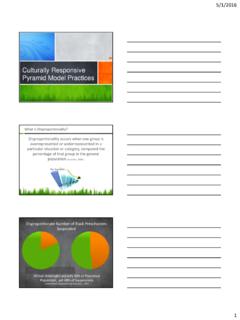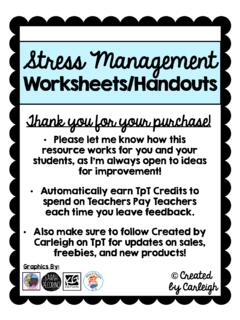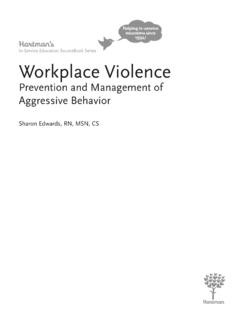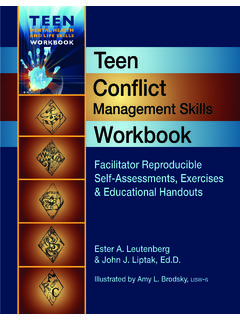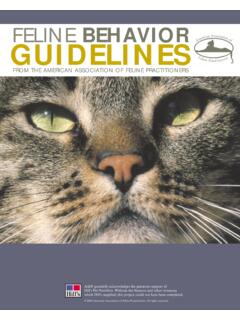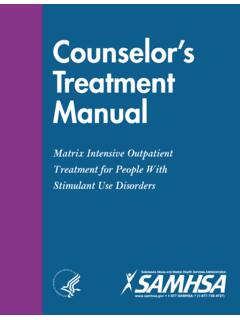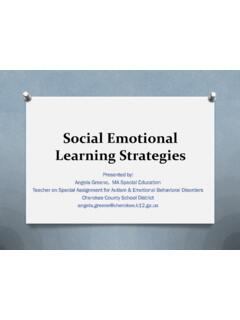Transcription of Co-Regulation: An Evidence-Based Approach to Building Self ...
1 Desiree W. Murray, PhD. and Kate Gallagher, Porter Graham Child Development Institute, University of North Carolina-CHKatie Rosanbalm, PhD., Center for Child and Family Policy, Duke UniversityCo-Regulation: An Evidence-Based Approach to Building Self-Regulation in Early ChildhoodAGENDA Overview of Self-Regulation Influences on Self-Regulation Development Understanding Co-Regulation Coaching Self-Regulation2 What is Self-Regulation?3 Self-Regulation act of managing cognitionand emotionto enable goal-directed actions such as: organizing behavior controlling impulses solving problems constructively 4 Murray et al., 2015. Foundations for understanding self-regulation from an applied developmental Report # 2015-21; Administration for Children and in Young Children Turn and Talk What does self-regulation look like during infancy, toddler-hood, preschool?
2 What are some common situations where children have difficulty self-regulating?6 What Skills do Young Children Need to Develop so they can Self-Regulate? Self-Regulation in Children with Disabilities8 Turn and Talk What can make self-regulation more challenging? What contributes to these challenges?Why is Self-Regulation Important? Foundational for success in school Predicts wellbeing and positive long-term development Problems with behavior regulation Suspension and expulsion from child care centers 8,000 preschoolers suspended every year Disproportionately boys and Black children About 20% are children with disabilities Rates of expulsion 3x as high as for school-aged children More than 10% of state-funded NC preschool teachers reported having expelled a childGilliam, 2005, DOE 2014 Connections to the DEC Recommended PracticesInteraction INT1.
3 Practitioners promote the child s social-emotional development by observing, interpreting, and responding contingently to the range of the child s emotional expressions. INT2. Practitioners promote the child s social development by encouraging the child to initiate or sustain positive interactionswith other children and adults during routines and activities through modeling, teaching, feedback, or other types of guided support. INT5. Practitioners promote the child s problem-solving behaviorby observing interpreting, and scaffolding in response to the child s growing level of autonomy and INS4. Practitioners plan for and provide the level of support, accommodations, and adaptationsneeded for the child to access, participate, and learnwithin and across activities and routines.
4 INS9. Practitioners use functional assessment and related prevention, promotion, and intervention strategies across environments to prevent and address challenging behavior. INS13. Practitioners use coaching or consultation strategies with primary caregivers or other adults to facilitate positive adult-child interactions and instruction10 Division for Early Childhood. (2014). What Influences Self-Regulation?11 How Families InfluenceSelf-Regulation (100+ studies) Parental warmthand sensitivity Harsh discipline and maltreatment Parents mental health Buffers the effect of stressors12 How ECE Programs Influence Self-Regulation Positive Teacher-Child Relationship:- Protects from risks of poverty -Promotes academic achievement and social adjustment Classrooms with effective behavior management :-Less disruptive, aggressive, and inappropriate behavior-Children more focused on learning Classroom management programs work!
5 -Increase teachers effectiveness and reduce stressHamre& Pianta, 2001; Piantaet al., 1995; Silver et al., 2005; Webster-Stratton & Reid, 2007, 2009 How stress Influences Self-RegulationTraumatic stress : ACEs and/or the accumulated burdens of poverty Increases vulnerability to future stress14 Harvard Center for Developing ChildSurvival Mode in the Context of stress Leads to a constant state of high alert:oFightoFlight oFreeze Harder to:oPay attention/stay on taskoRegulate emotionsoFollow rulesoInteract with others15 How Do Young Children Self-Regulate? Turn and TalkWhat are some ways you have observed that young children remain calm when stressed or calm down after being distressed? 16 What Helps to Strengthen Self-Regulation and Reduce stress ?Co-Regulation Warm, responsive caregiving and behavior coaching or scaffolding Skills InstructionIn cognitive, emotional, and behavioral domains of self-regulation 17 Murray, Rosanbalm, Christopoulos, 2016.
6 Report 2016-34. Office of Planning, Research, & Evaluation, Administration for Children and Families. Understanding Co-Regulation18 Co-Regulation Caregivers, educators, and professionals interact with young children to provide: 19 Warmth, nurturing, and a secure, safe relationship Support, coaching, and modelingto facilitate a child s ability to understand, express, and modulate their feelings, thoughts, and behaviorCapacity for Co-Regulation: It Helps to Be Mindful20 InteractionsInstructionMindfulnessAwaren ess resulting from non-judgmental attentionto our sensations, thoughts, and feelings in the present moment21 More mindful HS Professionals:Teachers have less conflict in their relationships with children. Home visitors reported better relationships with parentsWhitaker, et al.
7 , 2014, 2015 Teacher MindfulnessTeacher DepressionTeacher Child Relationship ConflictMindfulness, Depression and Teacher-Child InteractionsMINDFUL MOMENTCo-Regulation Strategies and Supports26Co-Regulation in Action A co-regulating teacher/practitioner will Buffer children from stress and adversity in the environment Provide a warm, responsive presence in times of distress Provide consistent structure and positive discipline Teach and model self-regulation skills Monitor, prompt, and coach the use of skills27Co-Regulation for Infants28 Infants Interact in warm and responsive ways Anticipate and respond quickly to child s needs Provide physical and emotional comfort when child is stressed Modify environment to decrease demands and stressCo-Regulation for Toddlers29 What can the parent do to help this child manage separation?
8 What can the teacher do?Co-Regulation for Toddlers30 Toddlers Reassure and calm child when upset by removing child from situations or speaking calmly and giving affection Model self-calming strategies Teach rules and redirecting to regulate behavior Co-Regulation for Preschool-Aged Children Instruct and coach use of words to express emotion and identify solutions to simple problems Coach rule-following and task completion Model, prompt, and reinforce (or coach ) self-calming strategies when child is upset Provide external structure and consequences31 Coaching Self-Regulation32 What to Coach with Preschoolers Using words (emotional literacy) Staying calm (emotion regulation) Using ignoring muscles (ignoring) Trying a friend s idea (social flexibility)
9 What Else to Coach with Preschoolers Waiting (patience)/ using patience muscles Staying focused and thinking hard (attention) Doing it all by yourself (independence while working) Sticking with something when it is hard (persistence) Trying different ways to solve a problem (flexibility/problem-solving)What do I actually do and say if I want to coach self-regulation? Describe examples of self-regulation that you see, using descriptive commenting:- You - I - It looks Praise self-regulation behaviors If a child is having trouble regulating:-Give coping statement-Make a positive predictionI bet you Coaching in Action(Vignette)Turn and Talk How is this teacher coaching? How are you using coaching currently? Is there anything new you might want to try with coaching?
10 36 What do you do to help children learn self-regulation skills?Turn and TalkWhen are good times to help children calm down?Intervene HereIrritability and ExplosivenessCalmIntervene HereTeaching Calm-Down Strategies Talk about and model coping with frustration or anger Practice calm-down skills like: Deep Breathing Smell the flower, blow out the candle Imagery Imagine you are relaxing in a soft cloud Think of happy place Positive self-talk I can do it Everyone makes mistakes Space and Materials to Support Calming DownTurn and Talk How might you use a calm-down spot in your classroom? What materials might you include in a calm-down spot? What rules might you set for your calm-down spot?40 Take Homes Self-regulation:-Contributes to functioning throughout life-Can be taught like literacy-Is harder for those with significant stress -Is strengthened by structured classrooms with warm, supportive teachers Co-regulation:-Supports self-regulation in moment -Builds skills developmentally -Depends in part on teachers own self-regulation skills-Produces significant improvement in child skills and behavior!
